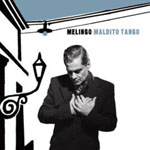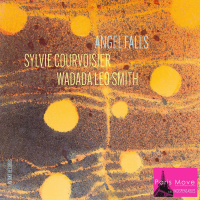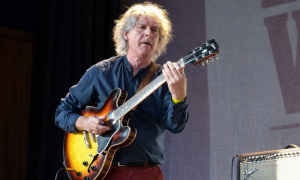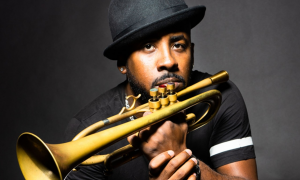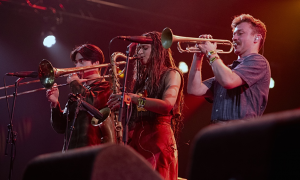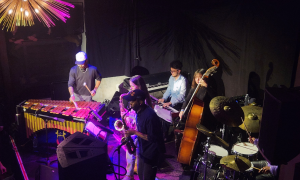Home » Jazz Articles » Live Review » Ottawa Jazz Festival 2008: Days 1-3, June 20-22, 2008
Ottawa Jazz Festival 2008: Days 1-3, June 20-22, 2008
Jazz at Lincoln Center with Wynton Marsalis
Cosmos /Harris Eisenstadt / Iro Haarla
TD Canada Trust Ottawa International Jazz Festival
Ottawa, Ontario, Canada
June 20-22, 2008
In the days leading up to the 2008 TD Canada Trust Ottawa International Jazz Festival, the forecast was: rain, rain, rain and more rain, not a good situation for a festival that, while running a number of series at indoor venues, places its biggest acts on its main outdoor stage at Ottawa's Confederation Park. Thankfully, at least for the first two days, fortune was with the festival, with warm, clear and summery conditions kicking the festival off in high gear.
At the 2007 festival the best shows were to be found offsite at the indoor series including the late afternoon Connoisseur Series at Library and Archives Canada, the early evening Improv Series at the National Arts Centre's Fourth Stage and the late night Studio Series at the NAC Studio—not to mention local bassist John Geggie keeping the even later night jam sessions exciting. This year's main stage program, however, is unusually strong and consistent, with something for everyone—big band repertoire with Wynton Marsalis and the Lincoln Center Jazz Orchestra (LCJO), Buddy DeFranco's small group swing, Charlie Haden's noir-centric Quartet West and mainstream piano trio excursions are only four of the festival's top shows.
But it's the trio of pianists Herbie Hancock, bringing his River: The Joni Letters (Verve, 2008) to town for one of only two Canadian dates; Chick Corea, whose electrically charged Return to Forever reunion tour has already been thrilling audiences in the United States; and Brad Mehldau, who follows up his 2006 trio performance at Library and Archives Canada with a return to the main stage, that will likely prove to be this year's biggest draws.
Still, there are plenty of exceptional shows programmed in the indoor series, most notably Finnish pianist/harpist Iro Haarla, who brings her quintet to the Improv Series to perform the music from the outstanding Northbound (ECM, 2006), the reed triptych of Tim Berne, Lotte Anker and Chris Speed, also at the Improv, bassist Renaud Garcia-Fons and drummer Harris Eisenstadt's Toronto Quartet at the Connoisseur Series, drummer Joel Haynes and the Davidson/Braid/Murley Quintet at the Studio Series and the remarkable Nordic Connect at the Great Canadian Jazz Series (at Confederation Park, held before each evening's headliner).
Plus, of course, there are always the surprises—groups little known or unknown, who manage to turn into sleeper hits for the festival. 2008 is a strong year and, in a time when most jazz festivals have to acknowledge the need to diversify to bring in a larger audience, while there are some deviations (but good ones, like Mali's Salif Keita), the festival remains surprisingly pure. It's jazz of a broad spectrum, but it remains undeniably a jazz festival. Chapter Index
- June 20: Jazz at Lincoln Center with Wynton Marsalis
- June 21: Cosmos
- June 22: Harris Eisenstadt Toronto Quartet
- June 22: Iro Haarla
June 20: Jazz at Lincoln Center with Wynton Marsalis
Trumpeter Wynton Marsalis may be one of jazz's most visible spokespersons, but he's also one of its most controversial—a dividing line between a reductionist view of jazz and a broader, more all-inclusive definition. Outspoken and opinionated, mention Marsalis at any online jazz bulletin board and watch it heat up.
 But forget about whether or not jazz is an American art form or if the inclusion of cultural influences from farther abroad are strengthening or diluting it. Marsalis is still a powerful technician and soloist, inventive arranger, democratic bandleader and engaging stage presence. But while the trumpeter did do all the introductions, in many ways he was just another member of the fifteen-piece big band, sitting with the trumpet section in the back row and drawing attention to himself only when speaking, which he did eloquently, or playing, which he did with precision and clarity.
But forget about whether or not jazz is an American art form or if the inclusion of cultural influences from farther abroad are strengthening or diluting it. Marsalis is still a powerful technician and soloist, inventive arranger, democratic bandleader and engaging stage presence. But while the trumpeter did do all the introductions, in many ways he was just another member of the fifteen-piece big band, sitting with the trumpet section in the back row and drawing attention to himself only when speaking, which he did eloquently, or playing, which he did with precision and clarity. With a crowd of 9,000 happy to be there (and in good weather), LCJO put on a set that was like a history of American jazz. Reaching back to the earlier part of the 20th century with a little New Orleans Dixie, the band most often stayed firmly in the center of the mainstream jazz tradition with material ranging from John Coltrane's "Giant Steps" and Joe Henderson's "Inner Urge" to a particularly beautiful take of Billy Strayhorn's "A Flower is a Lovesome Thing," Lee Morgan's "Ceora" and Jackie McLean's "Appointment in Ghana." LCJO may not be a progressive big band that's pushing the tradition forward, but nor is it a museum piece, concerned only with faithful recreation. The arrangements were sharp, the solo space plentiful and the groove swinging and irresistible.

It's hard to beat a band that features players like reed players Ted Nash—last seen in Ottawa in 2006 as part of local bassist John Geggie's annual concert series—Joe Temperley, whose baritone work was especially thrilling, and Victor Goines, whose tenor solo towards the end of the LCJO's nearly two-hour set was equally energizing. Marsalis wasn't alone as a standout in the trumpet section either—Ryan Kisor delivered his own distinctive solos that placed Marsalis in sharp contrast. Drummer Ali Jackson was the perfect blend of restraint and extroverted push, texturally painting "Ceora" but swinging hard on "Giant Steps."
There are those who are quick to dismiss Marsalis, based on his own view on jazz advocacy, but there's no denying the vibrant relevance of his playing—inside and outside the context of LCJO. When the music's this compelling, it's hard not to put aside personal issues with Marsalis' view of what jazz is, was and should be. When the music's this good—as the majority of the audience at Confederation Park, rising to their feet at the end of the set to demand an encore, would attest—the best thing to do is forget about thinking and just kick back and enjoy.
June 21: Cosmos
Following a light but substantive mainstream set from clarinetist Buddy DeFranco at Confederation Park that featured three of Canada's finest (who make regular stops at the OIJF)—pianist Bernie Senensky, bassist Neil Swainson and veteran drummer Terry Clarke—with the added surprise of impressive guitarist Joe Cohn, six- piece a capella vocal group Cosmos delivered a performance at the 10:30 PM Studio Series that may be an early runner for one of the festival's sleeper hits.
Then again, sleeper hit sometimes implies a less than substantial crowd, and the Studio was not just completely sold out, the festival had to turn people away. Hailing from Latvia, it was clear that the local embassy had done its job to let the Latvian community know about the show.
Ranging from 22 to 28 years old, the members of Cosmos may have looked like a boy band—and had the choreography and dress to go along with it—but they were all talented vocalists who comfortably married a pop sensibility with classical training, folk music and the subtlest hint of jazz harmonies. With Reinis Sejans providing a contemporary pulse through most of the set with his uncanny array of vocal percussion—and a crowd-pleasing Michael Jackson dance impersonation during the group's encore, the classic hit "Billie Jean"- -Cosmos may not be a jazz act, but it didn't matter to the enthusiastic crowd.

Tenor Juris Lisenko acted as the group's primary voice—and spokesperson, introducing many of the songs- -but everyone had their moment in the spotlight, notably bass Jonis Strazdins, who led the group on a lighthearted but impressive arrangement of Bobby McFerrin's hit, "Don't Worry Be Happy." The majority of the set was, in fact, largely spirited and aimed at entertaining the crowd, with a hilariously (and accurately) choreographed version of Genesis' "I Can't Dance" another highlight—not because of its almost iconic familiarity, but because of the remarkable way in which Cosmos adapted not just the musical parts of the original song, but the textures and timbres as well.
Lisenko reminded the audience, more than once, that they were listening to nothing more than human voices (well, with the exception of a jew's harp on one song, Sejans' use of looping on another and the soundman's use of delay and reverb to broaden the sounds of the voices), but it was often hard to believe. Sheer fun may have been the emphasis, but there were also unexpected passages of deep and profound beauty, where the six voices came together for a rich and expansive whole that was equally difficult to accept as the sound of only half a dozen singers.
Ranging from Strazdins' at times near subsonic voice to the piercing falsettos of Janis Sipkevics and Andris Sejans, Cosmos' range seemed limitless. Doo-wop mixing with beatbox; material ranging from original music from Turbulence (Cosmos, 2008) to innovative arrangements of popular pop tunes; it all added up to a show from a group that is already gaining ground in Europe and deserves to find its way to the public's ear in North America as well.
June 22: Harris Eisenstadt Toronto Quartet
He may have moved from his hometown of Toronto to the United States a number of years ago, but drummer Harris Eisenstadt still keeps ties with his Canadian friends. For his afternoon performance at the Connoisseur Series he brought his Toronto Quartet—despite none of the group actually coming from there. Bassist John Geggie is a local fixture on the Ottawa scene, keeping experimental jazz alive and well with his annual concert series at the National Arts Centre's Fourth Stage. Bassoonist Sara Schoenbeck is also US-based, amongst many projects working with composer/woodwind multi- instrumentalist Anthony Braxton, with whom she performed with his 12(tet)+1 at FIMAV in Victoriaville, Quebec in 2007. Baritone saxophonist David Mott is, indeed, the only Toronto resident (the group did have its germination with another Toronto player, cellist Matt Brubeck, who Geggie replaced for the Ottawa performance).
 The 85-minute set consisted of seven original compositions, written by Eisenstadt and Mott. Ranging from basic structures that provide a form around which to improvise (Eisenstadt's swinging "Convergence") to brief musical phrases that acted as focal and rallying points for more unfettered free play (Mott's "Phrases"). With a set that began in relative accessibility—though one of the remarkable aspects to the performance was that regardless how free the territory was, it was more about rounded surfaces than sharp edges, making it entirely approachable—the set gradually took off for more exploratory turf, which—defined by so many low-end instruments (perhaps the only high frequency range instruments in the group were Eisenstadt's cymbals)—was kept remarkably clear and defined in the room by soundman David O'Heare.
The 85-minute set consisted of seven original compositions, written by Eisenstadt and Mott. Ranging from basic structures that provide a form around which to improvise (Eisenstadt's swinging "Convergence") to brief musical phrases that acted as focal and rallying points for more unfettered free play (Mott's "Phrases"). With a set that began in relative accessibility—though one of the remarkable aspects to the performance was that regardless how free the territory was, it was more about rounded surfaces than sharp edges, making it entirely approachable—the set gradually took off for more exploratory turf, which—defined by so many low-end instruments (perhaps the only high frequency range instruments in the group were Eisenstadt's cymbals)—was kept remarkably clear and defined in the room by soundman David O'Heare. Eisenstadt's percussion was textural as he was rhythmic, a small kit with enough diversity on the cymbal front allowing him to evoke a rich variety of colors. But as open-ended as much of the music was, he was equally a part of suggesting soft pulses and more fervent backbeats, as he did later in the set with a riff- driven groove from Mott. If body language helps define how a drummer plays, Eisenstadt is relaxed, often leaning back, but occasionally leaning into the kit with deep concentration. Locked, tongue-in-groove with Geggie who, like Eisenstadt, ran the gamut from anchor to more intimate conversationalist, the drummer's writing was equally diverse, often involving irregular or shifting meters. While a generally freer player, Geggie was at his most Dave Holland-like on the gentle, but persistent groove of "Convergence." Intuitive, Eisenstadt's playing recalls the blend of pulse and color of Barry Altschul; no surprise, given Eisenstadt has studied with him.
Geggie's been growing at a more rapid pace in the past couple of years, and here his increasingly distinctive mix of spare lyricism and more abstract ideation worked particularly well. The quartet normally uses a cellist, and having an instrument with a lower range to compete with Mott's baritone and Schoenberg's bassoon had the potential for getting in each other's way, especially during the freer sections. But the group managed to interact and interrelate in ways that created a lush low-end texture that made the absence of higher register instruments unimportant. Geggie's experience playing with an increasingly impressive list of musicians including Myra Melford, Marilyn Crispell, Cuong Vu, Craig Taborn and Jon Christensen, along with his own studies and a dual career that's gradually blending classical and improvisation/jazz aesthetics into a personal whole, only makes it more important that he get the two records he has in the can out to the public.

Mott, whose focus on baritone has created its own niche that's been a big plus on projects like Jerry Granelli's Sandhills Reunion (Songlines, 2005)—also seen with that project at the Ottawa festival in 2006—and more mainstream affairs like the Nimmons 'N Nine Now Tribute Band, which will play Ottawa later in the festival on June 29, appeared to be in his preferred element here. From deep, growling bass riffs to more expansive excursions at the high end of his horn, he was part of a trio of low end instruments that seamlessly passed around the role of change-keeper when needed, jumping from a support role to lead voice at the drop of a hat. With a clear history in the tradition that brought a bluesy edge to one of his solos later in the set, it's clear that Mott's reach and inherent and near-immediate chemistry in virtually every situation makes him one of Canada's most eloquent and important saxophonists.
If there was a star of the show, however, it was Schoenbeck. Playing what may be the most difficult instrument on which to improvise, while other bassoonists like Dan Smith are making perhaps a bigger name for themselves to a mainstream audience, Schoenbeck is inarguably the more virtuoso and creative improviser. While opportunities abound in her work with Braxton, in the smaller, more intimate setting of a quartet—and especially one with the ability to move organically from form to freedom—from the audience perspective there was certainly a greater chance to hear what she could do. One of the highlights of the set was during a solo where, singing above her long, rich bassoon lines, it sounded very much like Tuvan throat singing, her voice creating subtle, overtone-like melodies to contrast the lower end of her horn. And while her instrument could be percussive at times, her tone was more often than not, warm and appealing.
Eisenstadt's performance may be one of the more avant-tinged performances to play the Connoisseur Series, and it may well have been a more appropriate group for the Improv Series. But by keeping things accessible even during its most outer-reaching collective improvisations, in no small part due to the attractive blend of the instruments, the Harris Eisenstadt Toronto Quartet put on a show that will undoubtedly go down as one of the best of the series.
June 22: Iro Haarla
Herbie Hancock may have been playing at Confederation Park, and there's little doubt that it impacted the attendance at Finnish pianist/harpist Iro Haarla's opening performance of the Improv Series. The attendance may have been small, and there's no doubt Hancock's show was terrific, but those who were in the audience for Haarla's show with her quintet, playing material largely culled from her outstanding ECM debut as a leader, Northbound (2005), was an artistic triumph of stark beauty, but with some significant differences to the recording.

First, the only other member of the Northbound quintet present was fellow Finn, bassist Uffe Krokfors. Krokfors has been playing with Haarla since their days with her late husband, drummer Edward Vesala and, their ongoing musical relationship has expanded to include other recordings including the somber duet recording Heart of a Bird (Tum, 2003) and the quintet recording Penguin Beguine (Tum, 2005). The Norwegian contingent on Northbound—saxophonist Trygve Seim, trumpeter Mathias Eick and drum legend Jon Christensen—were replaced by an all-Finnish line-up with trumpeter Verneri Pohjola, saxophonist/flautist Kari Heinila and drummer Dri Reino Laine, but within the first minutes of the opening "Yarra, Yarra..." it was clear that, while this quintet had its own approach, Haarla's writing and distinct harmonic approach were what gives any project a distinct identity. Laine was as capable of Christensen when it came to broad swatches of color, and time implied more than explicit, but equally he swung at times, in ways that the Norwegian drummer seems to have abandoned. Krokfors' bass tone was visceral, and his control and technique remarkable. As a rhythm partner with Laine he was both empathic and suggestive, using pedal tones to create tension during solos from his band mates, but it was his solos that were amongst the highlights of the set. Capable of deep melodiousness, he used subtle extended techniques to draw out unexpected sounds. Krokfors first emerged in his early twenties with Vesala, and went on to become a member of Krakatou with Scorch Trio guitarist Raoul Bjorkenheim, recording a number of discs for ECM. Here, however, in many ways he was at his best, with Haarla's writing allowing maximum flexibility within her often cued thematic passages.
Freedom comes in many forms, and it needn't be harsh or angular. While Pohjola in particular delivered a series of dazzling solos, with a remarkable embouchure that permitted him to radically change the timbre of his horn within a single phrase, sometimes even a single breath, Haarla's piano accompaniment was far from conventional. Jazz it is, but her harmonic conception is her own, steeped in ambiguity and implication and avoidant of any of the trappings of orthodoxy. Her classical training and the folk music of Finland inform her music and her playing as well. If Vesala's music was often aggressively turbulent, a maelstrom of whirling lines and colors, Haarla's is more gentle, but turbulent nevertheless. And with a more powerful rhythm section, the dynamics of the performance were even broader than those heard on Northbound.

Heinila was an intriguing saxophonist, capable of a sharp edge but often playing at a near-whisper. Haarla's composed lines for the saxophonist and Pohjola, whose interpretation sometimes blurred the lines between structure and nuanced exploration, intertwined in truly unique ways, often slow, almost languid but never weak. When he turned to flute at the opening of the second of two 45-minute sets for Northbound's opening, "Avian Kingdom," it brought a lighter texture to the piece than the original, which featured Trygve Seim on saxophone. The temporal elasticity and unpredictable hand-off of composed melody to improvisation made for a sound that was almost other-worldly or, at least, music that simply could not be created without the stark and sometimes somber beauty of the Finnish landscape. Haarla, as a pianist, drew comparisons to Carla Bley—not in her style, which in its classically-informed, often unresolved harmonic ambiguity, bore no resemblance whatsoever, but in her minimalist approach that favored thoughtful suggestion over direct explication. Her solos were abstract, but always based in melodic development and construct.
Finding a good harp is, according to Haarla, a challenge in almost any city, but the Ottawa festival managed to find a beautiful instrument and, thanks to some innovative miking and the use of a double-bass pickup by the Fourth Stage's soundmen, the small Ottawa audience was able to hear an instrument as rare in jazz as Sara Schoenbeck's bassoon at the Connoisseur Series performance earlier in the day. From sustaining cascades to soft, gently plucked melodies, Haarla on harp—especially at one point, where she was in duet with Krokfors—created an evocative canvass that, along with performances of her quintet, left an impression that may have been experienced by few, but will no doubt be heard about by many.
Coming up on days 4-6 of the Ottawa International Jazz Festival: Renaud Garcia-Fons, Corkestra, Lee Konitz, Mimi Fox, Amir Amir Trio and Tim Berne/Lotte Anker/Chris Speed.
Photo Credits
Photos of Iro Haarla and Uffe Krokfors: John Kelman
All Other Photos: John Fowler
Days 1-3 | Days 4-6 | Days 7-8 | Days 10-11
Tags
PREVIOUS / NEXT
Support All About Jazz
 All About Jazz has been a pillar of jazz since 1995, championing it as an art form and, more importantly, supporting the musicians who make it. Our enduring commitment has made "AAJ" one of the most culturally important websites of its kind, read by hundreds of thousands of fans, musicians and industry figures every month.
All About Jazz has been a pillar of jazz since 1995, championing it as an art form and, more importantly, supporting the musicians who make it. Our enduring commitment has made "AAJ" one of the most culturally important websites of its kind, read by hundreds of thousands of fans, musicians and industry figures every month.



